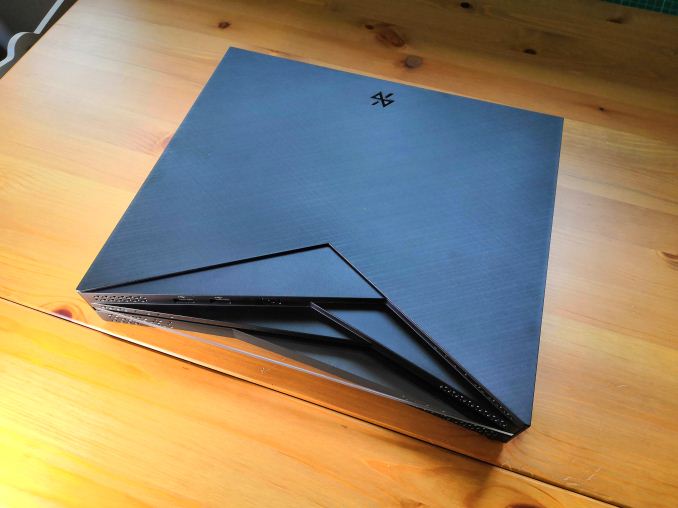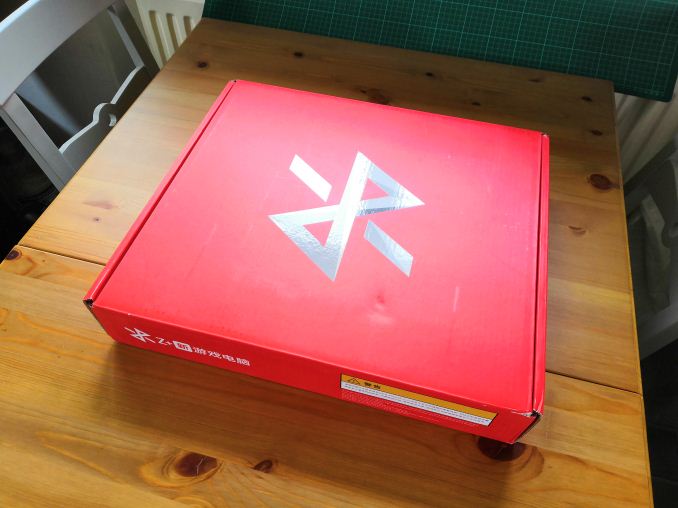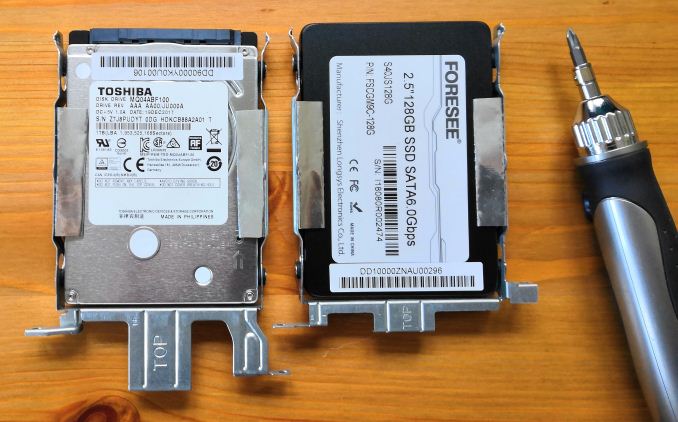A Quick Look at the Subor Z+ Console/PC Hybrid: A Custom AMD SoC Called FireFlight
by Ian Cutress on September 19, 2018 5:45 PM EST
One of the most interesting things in August (there were a lot) was that a company in China invested the best part of 400 million RMB / $60 million USD in a custom processor for its upcoming console and PC hybrid system. This processor comes from AMD’s Semi-Custom Division, and uses four Zen cores paired with 24 Vega compute units, making a beefy APU for a console system and a sizeable performer as a PC. One of the unique parts about the chip is that it uses GDDR5 for both CPU and GPU, which will be critical to its performance.
We have covered the initial launch of PlayRuyi’s Subor Z+ console in two articles, slowly going into more details as and when we get them:
- AMD Creates Quad Core Zen SoC with 24 Vega CUs for Chinese Consoles
- More Details About the ZhongShan Subor Z+ Console, with Custom AMD Ryzen SoC
On the back of those pieces, the product manager for the Subor Z+ got in touch with me via email. We have sent some questions back and forth, but the crux of the communication is that they have sent us a Z+ for review.
This is going to be fun. They’ve told as a lot. I mean, more than I ever expected. I'll save the juicy details for the full review.
The Z+ only arrived yesterday, so it's being tested for the full review. For now though, I wanted to publish something to whet the appetite. Be forewarned, I’m really bad at making videos like this. But here’s 25 minutes of starting the system up for the first time, and some benchmarks.
The codename for the SoC is ‘FireFlight’, which translates as Fenghuang. If some readers who were following the leaks on popular benchmarking websites were wondering, that’s the connection. It also explains why the graphics are labelled as ‘15FF’ – where FF stands for FireFlight.
On the hardware side, the console is listed as having:
- Four Ryzen Cores at 3.0 GHz, with Simultaneous Multi Threading
- 24 CUs of Radeon Vega, at 1.3 GHz, for 4 TFLOPs compute
- 8GB of GDDR5 at 256 GB/s
- OS Option 1 (PC Mode): Windows 10
- OS Option 2 (Console Mode): Windows 10 with Z+ Custom Interface
- Low Power Modes supported, with 30W 'background download' power
- 4.9 liter body, built-power supply, 'excellent' heat dissipation design
- 'Ultra-Mute' 33 dB at full horsepower
- Customizable appearance for unique designs
- 802.11ac WiFi, BlueTooth 4.1 (WiFi Module unknown)
- Storage is supplied through a 128GB M.2 SSD and optional 1TB HDD
- Audio stack supports SPDIF
- HDMI 2.0 is supported, as well as VR, 4K60, and HDCP 1.4
- System has four USB 3.0 ports and two USB 2.0 ports
We’ll aim for a full review in a couple of weeks, with our new GPU benchmark suite, as well as tests on the GDDR5. For now I need to work out what a good GPU comparison point might be. Kaby G? But that has HBM... Suggestions and thoughts are very welcome.














40 Comments
View All Comments
lamshing - Wednesday, September 19, 2018 - link
Seems subor is actually serious, they have set up a git repository https://github.com/suborEris_Floralia - Thursday, September 20, 2018 - link
Test against R9 380/285, RX570, GTX 1050Ti/1060?Also curious about how it compares to current consoles but that would be difficult to do tho
Dragonstongue - Thursday, September 20, 2018 - link
thats where PS5 and xbox "next" will come into play, seeing as they both already use "custom" cores based on jaguar and 7850 7950 levels of performance (tweaked of course)their next step will of course likely be Zen+ or Zen 2 and Vega (or likely a navi variant)
"hopefully" will also have at least 8gb usable ram and similar for the graphics core, as well as SSD storage system I would say "minimum" of 500 or 525gb now that their pricing has become much much better then when PS4 and Xbox were launched, as well as ensure USB and not funky stupid light bars and crap like that...in other words, hopefully they take more time to really go all out and make them "as good as they can be" to avoid careless mistakes.
they really should make their consoles more like a standard PC IMO
so there will still be need of laptops/notebooks for the "mobile" work, a higher performing game/media machine (consolized PC) and then of course a full out desktop type thing.
I can understand that they (MSFT/SONY) want to lock things down for good reason, but, there is much that can be said about the real awesome ability to be able to change fans or coolers and things like that (if needed) and if they want to make their consoles more and more "media" centric, then they need to bloody well get away from making them super proprietary crud, open them up a little, even if the "game mode" becomes a full locked down situation (Win 10 is already wanting/trying to go that route, why not go the extra mile and put this towards the console as well?)
now, in regards to this thing, is it ONLY a console, or is it truly a hybrid like consoles should have been quite awhile back, at the very least so the end user can easily swap out fans that die, change cooling paste or whatever....their secrets can stay theirs, but, new laws state the "warranty void if removed" is not lawful anymore, so, they should be more "open" to allow 3rd party fixing or changing things without having to pay big bucks to do a "simple" fix (which is anything but brain science if they use "standard" parts instead of micro connectors and such)
Ian Cutress - Thursday, September 20, 2018 - link
Watch the video. Answers most of your questions.dromoxen - Thursday, September 20, 2018 - link
None of the benchmarking tools know what it is yet afaik . Compare to 2200g/2400 and maybe i3-8350k/gtx1050 .. does that sound fair?esterhasz - Thursday, September 20, 2018 - link
I'd love to see the effect of the GDDR5 memory on non-gaming applications. Granted, 8GB is not enough for video editing, but at least in theory, this could be an interesting approach for performance growth in a post Moore's law future.Dribble - Thursday, September 20, 2018 - link
Not great as GDDR5 has significantly higher latency then DDR4, and for cpu's the lower latency is more important then the higher bandwidth.abufrejoval - Wednesday, September 26, 2018 - link
Still the latency issue may be somewhat compensated by caches. Actually I could imagine that some of the synthetic benchmarks could do quite well as they eat through large chunks of data profiting from the bandwidth, but the more random it is, the worse it will fare.And then I think that in real-life use, you wouldn't really notice the slowdown doing Excel or Word.
I'd love to get my hands on one to test...
ToTTenTranz - Thursday, September 20, 2018 - link
"For now I need to work out what a good GPU comparison point might be. Kaby G? But that has HBM... Suggestions and thoughts are very welcome."In my opinion, the best comparison would be with custom-made PCs with quad-cores and discrete GPUs that have a similar cost to the Subor Z+. In your earlier article, you mentioned the Subor costs $625 pre-tax, so with international distribution and tax I believe it would be something around $700 / 700€ / £630.
I think the most logical comparisons would be:
1 - Hades Canyon obviously, though price difference must be taken into account
2 - A $700 DIY PC on a mITX platform with the best possible components and AMD GPU (e.g. Ryzen 2200G / i3 8100, RX580 8GB)
3 - A $700 DIY on a mITX platform with the best possible components nvidia GPU (e.g. Ryzen 2200G / i3 8100, GTX1060 6GB)
In the end, it would be something like:
- Ryzen 3 2200G ~$100
- Gigabyte B450-I Aorus Pro ~$120 (already with WiFi AC module)
- 4GB + 4GB DDR4 2400 ~$70
- RX570 8GB or GTX 1060 3GB $220
- 128GB NVMe drive ~$80
- 1TB HDD ~$40
- Silverstone Mini ITX case ~$50
- Corsair/EVGA 350-400W PSU - $45
Total $725 plus shipping.
ToTTenTranz - Thursday, September 20, 2018 - link
Oops, I forgot to include a $100 windows license so... I guess the GPUs would have to go down to RX560 / GTX 1050 levels?Though an admittedly costlier solution with a GTX1060 3GB and a RX 570 should definitely be present, as well as e.g. a Ryzen 2400G to get the same 4-core/8-thread (2400G/2500X + RX570 might get close to performance parity with the Subor Z+). This could be present to show people exactly how much money they'd save with an integrated solution against a DIY performance equivalent.
In the end, it would tell us how much we'd gain or loose in performance, total power consumption, compactness and of course versatility/upgradability.